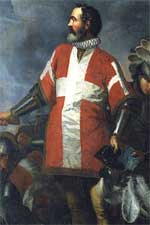The Siege Of Malta
The Great Siege of Malta took place between May-September 1565, when the small garrison of the Knights Hospitaller, also known as the Knights of Malta, heroically resisted a vastly superior invading Turkish force. Following one of the fiercest battles in history, the Knights emerged victorious.

Jean Parisot de La Valette
Grand Master and Commander
during the Siege Of Malta
The island of Malta is about seventeen miles long and nine broad. When the Siege of Malta took place, it had twelve thousand inhabitants, exclusive of the members of the order.
Malta: Fortifications and Geography
A narrow rocky promontory stretches out into the Mediterranean, dividing its waters into two small gulfs, Port Musiette to the west, and Valetta harbour (at the time of the Siege of Malta known as the Great Port) to the east.
At the extreme point of the promontory, the castle of St. Elmo was to be the first fort attacked when the Siege of Malta began. It was commanding the entrance into both harbours. Built on solid rock, it was washed, for the greater part, by the waters of the Mediterranean.
Towards the land, it was protected by a dry ditch and a counterscarp. On that side, it still looked vulnerable, so the Grand Master La Valette, who commanded the knights during the Siege of Malta, ordered a ravelin to be built, which was scarcely completed before the attack.
On the eastern side, two strips of land were forming smaller harbours within the Great Port. The most northerly of these strips of land was defended by the Fort or Castle of St. Angelo.
During the Great Siege of Malta, this was the most vital part of the island defense. Around the castle there was the little walled town named Il Borgo, where the Order took up its residence, while Castle St. Angelo was the Grand Masters' residence.
On a parallel strip of land, known as Sanglea, the Knights of Malta built another fort called the Fort of St. Michael. Both forts were destined to play a crucial role in the Siege of Malta. Between the two strips of land was situated the so called Port of Galleys, harbouring the navy of the Knights of Malta. This port was secured by an iron chain drawn across its entrance.
The Forces engaged in the Great Siege
The whole force which La Valette could deploy during the Siege of Malta was around nine thousand men. This included seven hundred knights, of whom about six hundred had already arrived, with the remainder on their way. Between three and four thousand were Maltese, with little experience, apart from fighting the Barbary corsairs. The rest of the army was made up of levies from Spain and Italy.
During the siege, the castle of St. Elmo was the point of first importance within the Malta defences. Its dimensions did not allow the holding of large quantity of provisions or military stores, so it had to rely on its communication with Il Borgo. The fort had thirty pieces of artillery, oriented towards the land, but the masonry was not in the best shape. Its garrison, which usually amounted to sixty soldiers, was under the command of an aged knight, named De Broglio. The Grand Master reinforced it with sixty knights under Negropont, and two companies of foreign levies, under La Cerda, a Spanish knight.
The main force of the Knights was posted in the castle of St. Angelo and in Il Borgo. During the Siege of Malta, La Valette had its headquarters here, as this central position enabled him to coordinate all his forces.
On the morning of the 18th of May, 1565, the Turkish fleet was spotted by the sentinels of St. Elmo and St. Angelo. It had 193 ships, including 131 regular galleys, seven small galleys, four large galleys, with the rest transport vessels. Among the artillery pieces, there were sixty-three high calibre guns for pounding the walls, some of them able to fire marble bullets of a hundred and twelve pounds. The number of soldiers on board was about thirty thousand, including six thousand janissaries, the best of Ottoman army.
The beginning of the actual siege was preceded by skirmishes in which the Knights of Malta defeated some landed Turkish detachments.
The Commanders
The Knights of Malta:
Jean Parisot de La Valette, Grand Master of the Order of the Knights of Malta
The Ottoman force:
Fleet - Piyale Pasha, a converted Croatian, the admiral who defeated the Spaniards at Gelves.
Land forces - Mustafa Pasha, a veteran with great experience.
According to Suleiman's plan, the Great Siege was intended to exterminate the Knights of Malta, as they were his most formidable opponents in the Mediterranean. That is why he decided that both officers were to report to Turgut Reis (Dragut), his most trusted admiral. However, in using three commanders, Suleiman may have contributed himself to the outcome of the Siege of Malta.
How the Siege was fought: